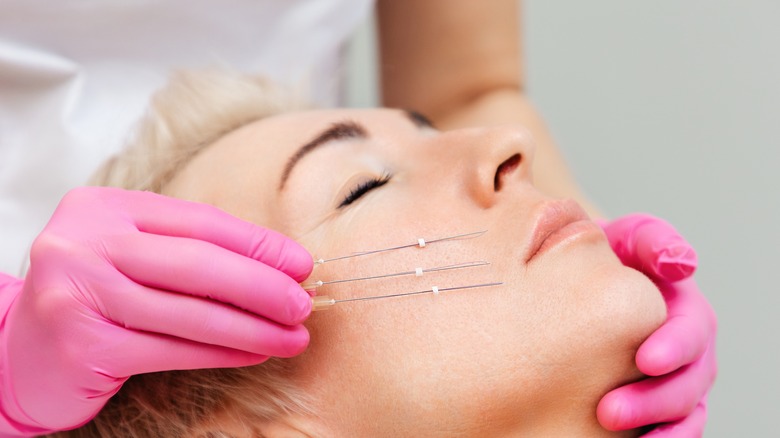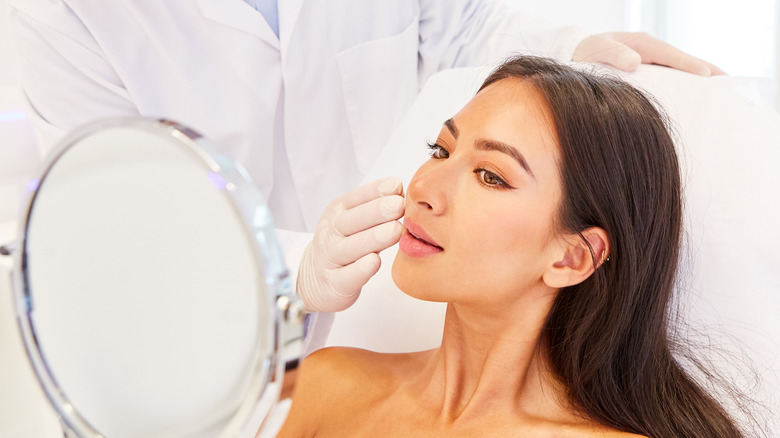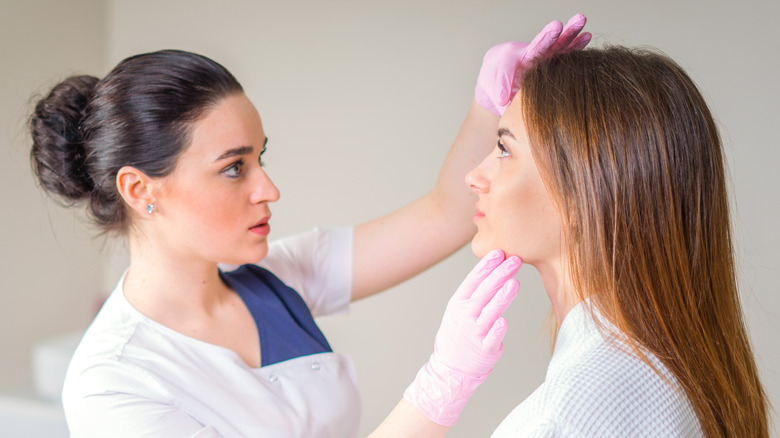Here's What You Should Know Before Getting Mono-Threads
It's no secret that cosmetic procedures are on the rise. According to a recent survey by The American Society of Plastic Surgeons, almost 30% of cosmetic practitioners reported seeing at least double the number of patients seeking procedures compared to pre-pandemic levels. "More people were using video technology, and they became more aware of what they looked like in a public setting," explained Dr. Edward Reece to Baylor College of Medicine when asked about the cause of the growing interest.
Although the prevalence of Zoom calls undoubtedly drove some of us to seek cosmetic enhancements, celebrity and social media influence has also played a part. Speculation about the possible work performed on celebrities is rampant throughout internet forums and social feeds, and some stars have even opened up about their plastic surgery experiences. One actress willing to open up is Eva Mendes, who documented her experience with an innovative approach called mono-threading in a now-removed Instagram post shared by People.
Mono-threading and other thread lifts are gaining traction for their transformative effects, but they're not quite as well-known as interventions like Botox and fillers. Here, we'll unravel everything you need to know about mono-threads, including expert opinions on the procedure's effects.
What exactly is thread lifting?
You may not have heard much about thread lifting because it's a relatively new procedure in the field of cosmetic enhancement. Research featured in The Aesthetic Surgery Journal reports that thread lifting has been used as a surgical technique since the 1960s.
However, the beginnings of thread lifts as we know them can be traced to 1992 when plastic surgeon Dr. Gregory L. Ruff explored their use while treating a patient with a cheek deformation (via The New York Times). By threading the tissue beneath the skin's surface with a needle or cannula, similar to stitches, Dr. Ruff discovered a novel way to firm and lift its outer appearance. He took things a step further by implementing barbed threads, which could grip the tissue more efficiently. According to a study published in The Archives of Aesthetic Plastic Surgery, the FDA approved thread lifts for cosmetic use in 2005. Starting with the introduction of Dr. Ruff's barbed thread design, thread lifts have evolved to include varied types of threads to address specific skin concerns.
How do mono-threads differ from other thread lifts?
Surgeons use different types of thread lifts to achieve certain effects, and they can assess which material and thread type is best for each patient's needs. A report featured in The Journal of Dermatology & Cosmetology states that the material used in procedures for the longest amount of time is polydioxanone or PDO. Practitioners use PDO thread lifts to amplify collagen production, with their effects typically lasting around six months.
Alternative thread lifts to PDO include polylactic acid (PLA) and polycaprolactone (PCA). PLA and PCA threads treat sagging and add volume to hollow areas, whereas PDO threads subtly rejuvenate the skin's appearance. Although PLA and PCA thread lifts can stimulate collagen production over a longer period, doctors prefer PDO thread lifts for patients who haven't yet encountered issues with skin laxity (via research published in the Journal of Cosmetic Dermatology).
According to The International Fellowship In Advanced Aesthetic Science, mono-threads are a type of PDO thread lift that can benefit younger patients seeking a refreshed appearance. Unlike the threads typically used to promote facial volume, referred to as screw or cog threads, mono-threads have one filament without barbs or interweaving. "'For thinning skin, the placement of smooth, hair-thin mono threads will, in the long run, create a collagen boost for organic and natural skin rejuvenation results," Dr. Mahsa Saleki tells Women's Health.
Patient experiences with thread lift procedures
In online communities where patients gather to discuss cosmetic enhancement outcomes, reviews vary regarding thread lifts. Some find the procedure worth trying and note that they've seen surface improvements in skin texture and sculpting effects. "I've been getting PDO threads yearly for three years now, ever since I started noticing dark jowling lines forming, and they've never come back ... The cumulative effect of PDO threads have given me a much sharper and contoured face shape," Redditor Donutsforbrunch stated in the PlasticSurgery subreddit.
Others are not convinced that the treatment lives up to the hype and claim they've experienced dismal results. RealSelf reviewer tobdeterm1ned had high hopes for their thread lift but was ultimately disappointed by its side effects. "I'm now at five weeks post-procedure, and all the threads are still visible, and there's a lump at one entry point. Sadly, this is the only noticeable change from before and after my visit," they wrote.
Still, some recipients find that thread lifts do work as intended; they just don't last very long. A study published in The Archives of Facial Plastic Surgery concluded that thread lift patients showed brief improvement, but the aesthetic effects quickly wore off.
Risks and complications associated with mono-threads
Mono-thread treatments are minimally invasive and require less recovery time compared to traditional facelifts, but thread lifts are not trouble-free. While mono-threads are less complex than screw or cog thread types, their insertion may lead to dimpling, infection, swelling, and pain. The most severe outcome associated with thread lifts is nerve damage, but surgeons generally insert mono-threads superficially enough so as not to pose any risk.
The American Society of Plastic Surgeons emphasizes that serious side effects of thread lifts are rare, and removing threads can reverse minor complications. Nevertheless, some physicians oppose thread removal and suggest you allow any irregularities to heal on their own to avoid further damage to the skin. Everyone heals differently, so allow yourself ample time to recover if you're considering the procedure. Even those who support thread lifts warn that you shouldn't book the treatment without making preparations. "The downtime is not a lunch. It can be a day or a week, depending on the area that is being done," Greg Toso, marketing director of thread distributor Surgical Specialties, tells The Chicago Tribune.
Who can benefit from mono-threads
Mono-threads are ideal for those who seek increased firmness and refreshed-looking skin but aren't ready for aggressive treatment options. "[Threading is] a middle ground between fillers and surgery and represents a dramatic advancement in nonsurgical facial rejuvenation," Dr. Gerald Pierone, Jr. told Dermatology Times. There are a few circumstances where surgeons don't recommend mono-threads. People prone to keloid scarring, those with immune system ailments, and those who are pregnant or nursing are unsuitable candidates for thread lift procedures.
While thread lifts like mono-threads can offer increased collagen production and taut skin, it's important to keep realistic expectations. "[Thread lifts] can be a good option for someone looking for an easy, less costly option for facial rejuvenation but can accept a result that is less dramatic than a face-lift and isn't as long-lasting," Dr. Darren Smith told Allure. Some doctors suggest that certain skin types are more likely to benefit from mono-threading and other thread lifts. If you're unsure whether you would be a right fit for the treatment, it's best to book a consultation with a thread lift practitioner so they can appropriately assess your skin.





